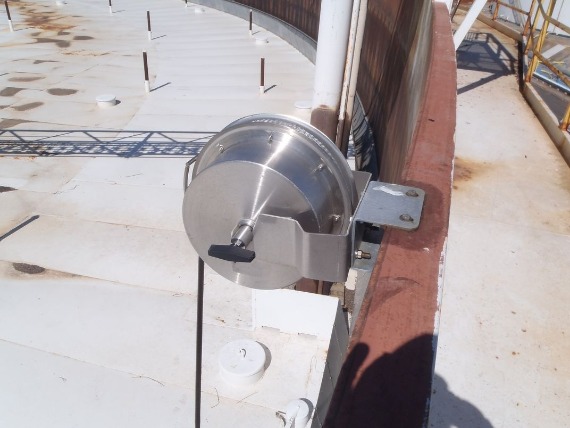Retractable grounding assembly 750
Comprehensive Lightning Strike Protection for Floating Roof Tanks
- Pre-Tensioned: The RGA 750 is pretensioned at the factory, so no on-site tensioning is required.
- Corrosion Resistance: New aluminum cable originally developed for marine use greatly improves corrosion resistance and is highly resistant to hydrogen sulfide (H2S)
- Easy-to-Install: Installation takes only two hours on both new and existing tanks
- Effective: Permanent, reliable, low-impedance bond prevents fires triggered by lightning currents
- Durable and Low Maintenance: Engineered for years of durability and reliable performance in corrosive environments and requires virtually no upkeep as compared to shunts
- Standards Conformant: The RGA conforms to both API 545 and NFPA 780 recommendations and meets the API 545 requirements for a bypass conductor API 545 and NFPA 780 and complies with API 545 requirements for a bypass conductor
The ATEX approved and patented RGA substantially reduces the risk of tank fires by subduing sustained arcs during lightning events and other electrical phenomena.
The RGA does this better than other traditional methods for bonding floating roofs because the retractable cable is always at the shortest possible length. The resultant low resistance and impedance results in too low of a voltage to sustain the arc, i.e., no fire.
If you have any questions, please contact us via Whatsapp or our contact form. We will be glad to help you.
Floating Roof Tank Fires are Common
There are 15 to 20 known floating roof tank (FRT) fires per year. FRT’s are especially vulnerable to the direct and indirect effects of lightning. A direct or a nearby lightning strike will cause electrical currents to flow across the tank shell and roof. When these lightning currents arc across the roof/shell interface, they can ignite any flammable vapors that may be present. It is therefore necessary to bond the roof and shell to prevent arcing at the roof/shell interface.
Substantially reducing the risk of sustained arcs requires a reliable, full-time, low impedance and low-resistance connection between the tank shell and roof. Additionally, the connection must operate regardless of the tank shell’s condition.
The RGA is not affected by the condition of the tank because the RGA and cable are bolted and sealed to optimal locations on the tank shell and floating roof. When properly applied, multiple RGAs on each tank provide low-impedance pathways to safely discharge lightning currents.
The RGA is designed to retrofit easily onto any existing tank, even those in service and is also easy to inspect and is constructed to be low maintenance.
The new RGA 750 uses stronger springs to retract the cable.
The Limitations of shunts
To combat the risk of rim fires, the industry has been using metal strips called “shunts” that electrically bond the shell and roof of the tank.
Unfortunately, the bond that these shunts establish is unreliable and creates a greater risk of sustained arcs:
- Rust, waxy deposits, and paint can line the inner wall of the shell, thus increasing resistance
- The floating roof can drift slightly off-center and disconnect some of the shunts from the shell
API Testing proved that shunts will arc under all conditions, even if the tank wall and shunts are new and clean.
Other uses
We recommend the use of the RGA with internal floating roofs.

